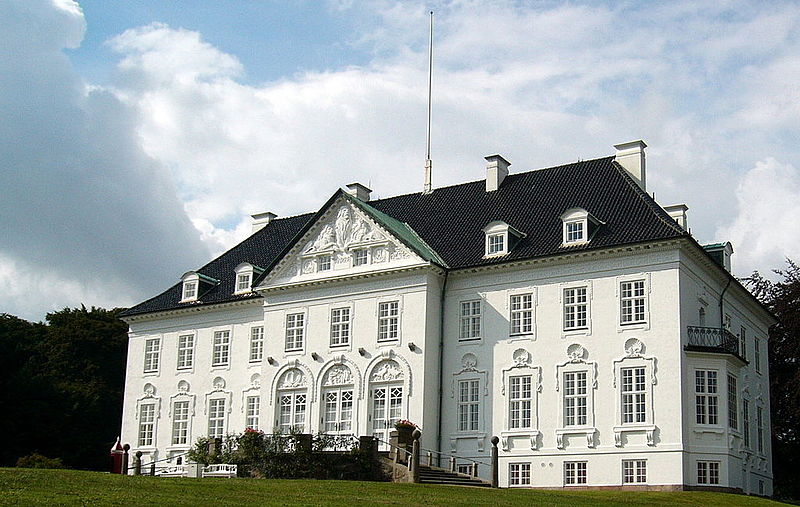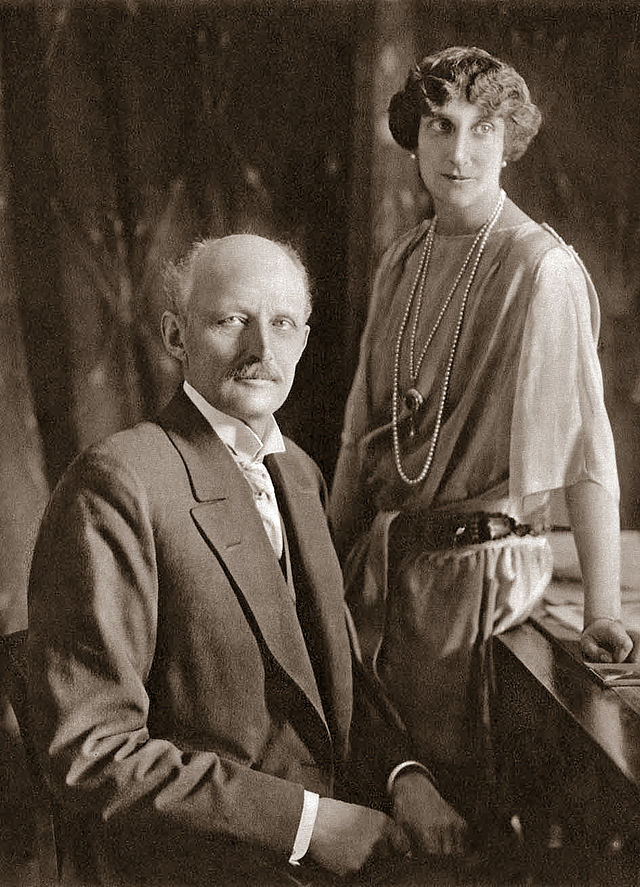by Susan Flantzer © Unofficial Royalty 2015

Christian IX, King of Denmark by Unknown photographer, postcard print, NPG x28085 © National Portrait Gallery, London
The ancestor of six of the ten current European monarchs (Philippe, King of the Belgians, King Frederik X of Denmark, Grand Duke Henri of Luxembourg, King Harald V of Norway, King Felipe VI of Spain, King Charles III of the United Kingdom, and two former monarchs (the late King Michael of Romania and the late King Constantine II of Greece), King Christian IX of Denmark was not born destined to be a king.
King Christian IX was born a German prince, the sixth child and fourth son of Friedrich Wilhelm, Duke of Schleswig-Holstein-Sonderburg-Beck and Princess Louise Caroline of Hesse-Kassel, on April 8, 1818, at Gottorp Castle near the town of Schleswig in the Duchy of Schleswig (now Germany). Through his father, Christian was a direct male-line descendant of King Christian III of Denmark. Through his mother, Christian was a great-grandson of King Frederik V of Denmark, and also a great-great-grandson of King George II of Great Britain. In 1825, Christian’s father became Duke of Glücksburg and changed his title to Duke of Schleswig-Holstein-Sonderburg-Glücksburg.
Christian had nine siblings:
- Princess Luise Marie of Schleswig-Holstein-Sonderburg-Glücksburg (1810 – 1869), married (1) Friedrich von Lasperg, no issue; (2) Alfred, Graf von Hohenthal, no issue
- Princess Friederike of Schleswig-Holstein-Sonderburg-Glücksburg (1811 – 1902), married Alexander Karl, Duke of Anhalt-Bernburg, no issue
- Karl, Duke of Schleswig-Holstein-Sonderburg-Glücksburg (1813 – 1878), married Princess Vilhelmine Marie of Denmark, no issue
- Friedrich, Duke of Schleswig-Holstein-Sonderburg-Glücksburg (1814 – 1885), married Princess Adelheid of Schaumburg-Lippe, had issue
- Prince Wilhelm of Schleswig-Holstein-Sonderburg-Glücksburg (1816 – 1893), unmarried
- Princess Luise, Abbess of Itzehoe (1820 – 1894), unmarried
- Prince Julius of Schleswig-Holstein-Sonderburg-Glücksburg (1824 – 1903), married Elisabeth von Ziegesar, no issue
- Prince Johann of Schleswig-Holstein-Sonderburg-Glücksburg (1825 – 1911), unmarried
- Prince Nikolaus of Schleswig-Holstein-Sonderburg-Glücksburg (1828 – 1849), unmarried

Glücksburg Castle; Credit – by Wolfgang Pehlemann – Own work. Licensed under CC BY-SA 3.0 via Wikimedia Commons
Until he was seven years old, Christian lived at his birthplace, Gottorp Castle. In 1825, when Christian’s father became Duke of Glücksburg, the family moved to Glücksburg Castle, now in Schleswig-Holstein, Germany. Christian’s father died in 1831 at the age of 46, and King Frederik VI of Denmark along with Prince William of Hesse-Philippsthal-Barchfeld became the guardians of Prince Christian and his nine siblings. King Frederik VI was the first cousin of Christian’s mother and was married to Christian’s maternal aunt Marie.
At the age of 14, Christian was sent to Copenhagen, Denmark for officer training at the Military Academy of Copenhagen. He lived with Colonel Linde, head of the military academy, received private lessons, and was rarely with the other cadets. King Frederik VI and Queen Marie were also involved in the upbringing of Christian and he frequently stayed with them. In 1836, he was appointed a captain of the Royal Horse Guards and lived in the barracks at Frederiksholms Channel in Copenhagen. In 1839, King Frederik VI gave Christian the Yellow Palace next to Amalienborg Palace, the home of the Danish monarchs, in Copenhagen, Denmark. Christian lived at the Yellow Palace until 1863 when he became King of Denmark.

Yellow Palace; Credit – Wikipedia
From 1839 to 1841, Christian studied constitutional law and history at the University of Bonn (now in Germany). While studying at the university, Christian received the news of the death of King Frederik VI of Denmark on December 3, 1839. Because Frederik VI only had surviving daughters, he was succeeded by his cousin King Christian VIII of Denmark. During the holidays from his university studies, Christian traveled through various German monarchies. On one of these trips, he visited Castle Rumpenheim in Hesse, where he took an interest in his future wife, Princess Louise of Hesse-Kassel.

Louise, Queen of Denmark; Christian IX, King of Denmark by François Deron, albumen carte-de-visite, early 1860s, NPG x74387 © National Portrait Gallery, London
Princess Louise of Hesse-Kassel was born in Kassel, Landgraviate of Hesse-Kassel, now in the German state of Hesse on September 7, 1817. Her parents were Prince William of Hesse-Kassel and Princess Charlotte of Denmark, a granddaughter of King Frederik V of Denmark. On May 26, 1842, Louise married her second cousin Christian at Amalienborg Palace. After the wedding, the couple lived at the Yellow Palace in Copenhagen, Denmark.
Christian and Louise had six children:
- King Frederik VIII of Denmark (1843 – 1912), married Princess Louise of Sweden, had issue
- Princess Alexandra of Denmark (1844 – 1925), married King Edward VII of the United Kingdom, had issue
- Prince Vilhelm of Denmark, who became King George I of Greece (1845 – 1913), married Grand Duchess Olga Konstantinovna of Russia, had issue
- Princess Dagmar of Denmark, Maria Feodorovna after marriage (1847 – 1928), married Alexander III, Emperor of All Russia, had issue
- Princess Thyra of Denmark (1853 – 1933), married Crown Prince Ernest Augustus of Hanover, 3rd Duke of Cumberland and Teviotdale, had issue
- Prince Valdemar of Denmark (1858 – 1939), married Princess Marie of Orléans, had five children

Christian IX, King of Denmark and his family by Georg Emil Hansen, albumen carte-de-visite photomontage, 1862, NPG x74402 © National Portrait Gallery, London
The couple had 39 grandchildren and their grandsons included Nicholas II, Emperor of All Russia, King Constantine I of Greece, King George V of the United Kingdom, King Christian X of Denmark and King Haakon VII of Norway. Over the years, numerous large family reunions were held at Fredensborg Palace with children, in-laws, grandchildren, and great-grandchildren.
A story has been told about King Christian IX. Whether it is true or not, it illustrates his relationship with other European monarchies:
Christian and his court lived simply, largely because of economics. One day, Christian and his son William (George I of Greece) and the husbands of two of his daughters went for a walk. They encountered a country gentleman who wondered who they were, thinking they were guests of some local squire. “I am your king,” explained Christian. “This is my son, the King of Greece, and this is my son-in-law, the Tsar of Russia (Alexander III of Russia), and my other son-in-law, the Prince of Wales (the future Edward VII of the United Kingdom).” The man was not impressed and said, “All right, I’ll tell you who I am. I am Jesus Christ!”

King Christian IX with his family gathered in the Garden Hall of Fredensborg Palace in 1883 by Laurits Tuxen; Credit – Wikipedia
So how did King Christian IX become King of Denmark? When King Christian VIII died in 1848, he was succeeded by his son King Frederik VII, who had married three times but had no children, and this resulted in a succession crisis. Louise, Christian IX’s wife, had lived in Denmark from the time she was three years old. She was a niece of King Christian VIII of Denmark and a closer heir than her husband. Women could inherit the Danish throne only if there were no male heirs (Semi-Salic Law), and Louise and her mother both rescinded their succession rights to Christian, Louise’s husband, in 1851. The Act of Succession of 1853 officially made Christian the heir of King Frederik VII, and he became king in 1863 when King Frederik VII died.
As soon as he became king, Christian was thrust into a conflict with Prussia over the Schleswig and Holstein, two duchies just to the south of Denmark. This was known as the Schleswig-Holstein Question, a complex issue regarding the relationship of two duchies to the Danish crown and to the German Confederation. Lord Palmerston, former British Prime Minister said of it, “The Schleswig-Holstein question is so complicated, only three men in Europe have ever understood it. One was Prince Albert, who is dead. The second was a German professor who became mad. I am the third and I have forgotten all about it.” The Second Schleswig War between Denmark and a Prussian/Austrian alliance in 1864 resulted in the Danish loss of both Schleswig and Holstein to Prussia. It was not publicly known until 2010 that King Christian IX secretly contacted the Prussians, offering that Denmark would join the German Confederation if Denmark could stay united with Schleswig and Holstein. This proposal was rejected by Otto von Bismarck, German Chancellor. The bitterness in Denmark over the loss of Schleswig and Holstein lasted a long time.
Queen Louise, aged 81, died on September 29, 1898, at Bernstorff Palace near Copenhagen and King Christian IX died at age 87 on January 29, 1906, at Amalienborg Palace in Copenhagen. Both were buried in the Glücksburger Chapel at Roskilde Cathedral in Roskilde, Denmark.
This article is the intellectual property of Unofficial Royalty and is NOT TO BE COPIED, EDITED, OR POSTED IN ANY FORM ON ANOTHER WEBSITE under any circumstances. It is permissible to use a link that directs to Unofficial Royalty.
Kingdom of Denmark Resources at Unofficial Royalty
- Kingdom of Denmark Index
- Danish Orders and Honours
- Danish Royal Burial Sites: House of Oldenburg, 1448 – 1863
- Danish Royal Burial Sites: House of Schleswig-Holstein-Sonderburg-Glücksburg, 1863 – present
- Danish Royal Christenings
- Danish Royal Dates
- Danish Royal Residences
- Danish Royal Weddings
- Line of Succession to the Danish Throne
- Profiles of the Danish Royal Family



























